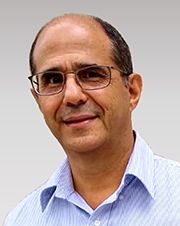The new paradigms in seismic inversion
OR
SEG members, view the course for free!
Format: Virtual Webinar. 45 min. presentation followed by 15 min. Q&A
Please note that two sessions will be given on different dates listed below.
Session 1, Wednesday, Sept 22, 2021, 3 pm to 4 pm Rio de Janeiro Time
Session 2, Tuesday, Nov 23, 2021, 10 am to 11 am US Central Time
Two live sessions are completed. Please scroll down to watch the videos from the recordings below. SEG members, view the course for free!
Abstract
Seismic inversion comprises the methods to infer medium properties from seismic recorded signals. Seismic inversion of reflected P-wave amplitudes has been a powerful tool to characterize oil and gas reservoirs, being applied in a standard manner to the analysis of seismic surveys in the industry. Lithology mapping, porosity estimation, and fluid discrimination are common applications. As the technology evolves toward a new generation of tools and instruments, the renewal of paradigms for seismic inversion takes place to make reservoir description faster, more precise, and quantitatively integrated across multiple data.
A first major shift involves the adoption of elastic Full Waveform Inversion (FWI) as a privileged tool for seismic data analysis. Instead of being limited to P-wave reflections, elastic FWI analyzes the full-wave phenomenology, including phase conversions, diffractions, refractions, and multiples. The approaches that focus on the elastic FWI in target regions are promising for the efficiency of the technique. Another methodological change, supported by the increasing availability of computational resources, involves using sampling approaches and neural networks for seismic inversion, instead of the common deterministic optimization algorithms. Sampling approaches, such as Markov Chain Monte Carlo, not only infer a likely configuration of the medium properties but the probability distribution of the properties and structural parameters. Non-linear estimation based on Convolutional Neural Networks also shows useful for seismic inversion and characterization, after appropriate training. Finally, a paradigm shift of large impact on speed, simplification, and reliability of reservoir model building is the quantitative integration of multiple collected data. Knowledge networks linking theory, models, and data of major reservoir static and/or dynamic processes are the promise for semi-automated and quick assimilation of the reservoir sensor data. In parallel, more flexible and denser field instrumentation, as well as multi-physics sensors are being developed.
This presentation will provide an outline of the methods illustrated with examples.


Your Instructor

Miguel Bosch’s expertise is in the field of geophysical inversion with a focus on advanced seismic inversion methods and data integration in complex reservoir models. He has worked in inference problems at different earth scales. In the topic of oil and gas reservoir description, he develops services and technology for the upstream oil and gas industry. Miguel has supervised a large number of projects on seismic inversion, reservoir characterization, and integration, and developed advanced technology and software for these fields. His recent research involves focused Full Waveform Inversion and quantitative Knowledge Networks for data integration. He graduated with a PhD in Geophysics from the Institut de Physique du Globe de Paris, working with Albert Tarantola, and was a full professor and Head of the Applied Physics Department at the Universidad Central de Venezuela. He is an active member of the SEG, AGU, EAGE, IAMG, AAPG, GSH and serves as associate editor in the area of reservoir geophysics for the journal Geophysics. He is presently the founder and CEO of Info Geosciences Technology and Services.
